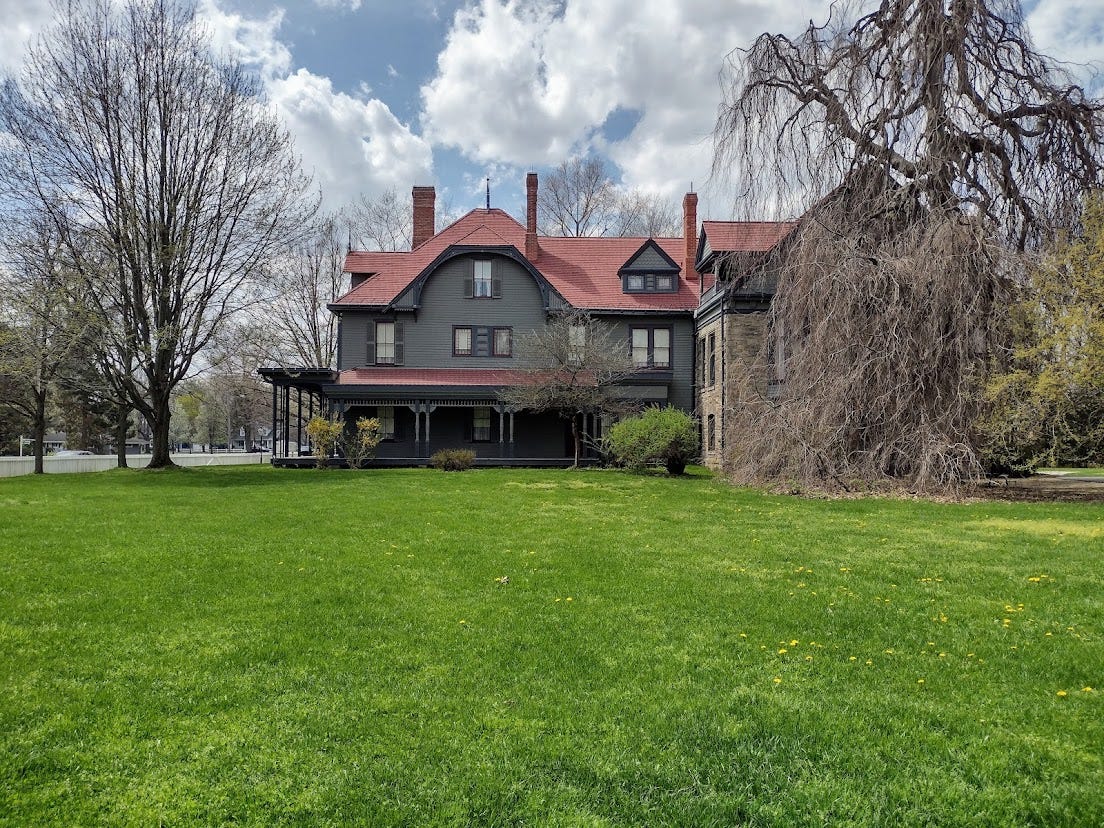
This is an Annette on the Road post at Non-Boring History, in which your host, historian Annette Laing, plays tourist around the US and UK.
Voiceover podcasts of NBH posts are normally only available to paid subscribers, but this time, it’s a free sample. Join us today to get every one Annette records!
Note from Annette
James Garfield belongs to that select group of American presidents whom people remember—if at all— for being assassinated.
Look, I’m not an exception to “people”. I’m a historian, sure. Dr. Laing, that's me! But historians don't know everything about history. Not even in our own subjects. Not even close. Or close to close.
Hoosen and I did not mean to stop at President James Garfield’s home. But while Hoosen was peering at our tires in this land-that-time-forgot-yet-cool gas station parking lot in Mentor, Ohio, I peered at Google Maps. I noticed we were a half mile from the James A. Garfield House, and that it’s owned by the National Parks Service.
Sorry, libertarians, but even non-historian Hoosen has noticed that a federal government museum is a guarantee of high quality, and as is sometimes the case, as here, it means free admission. Think of the taxpayer value as I spread the word and you read it! Trust me, there's no commercial value in a Garfield museum, but there is value.
This museum isn't about Garfield's extremely short presidency (100 days) much less his political career. It's about James Garfield’s home, and what happened to that home after his untimely death.
Home, Sweet Home!
Middle class Victorians—American and British— put the family home on a pedestal. Until now, the home for most Americans had been a workplace, a farm or a shop or a workshop, where the whole family worked together, ate, and slept.
But big changes in the economy in the 19th century meant that many men of the new middle class now left the home to work, kind of the reverse of going remote. Such men now thought of home sentimentally, as a cosy refuge from a cruel and complicated world. Their wives (typically more educated than their predecessors) continued to stay home, but now had servants to do much of the drudgery. Middle-class women were encouraged to consider the home their domain.
The Garfields were no exception. This estate, Lawnfield, is their home, and it appears largely as it did when Mrs. Garfield died. The lawn of its name would become more important than the field.
When the Garfields bought Lawnfield, however, it was a working farm. Garfield bought this place because he wanted his kids to grow up on a farm, just like he had, only with more money.
James Garfield thought that farms were an essential part of a great, healthy childhood. Which is striking, because James Garfield was an unlikely champion of the “good old days”: He helped usher in the modern age.
Garfield fought in the Civil War, tried to improve civil rights and education for newly freed slaves, and even participated in the great money grab as the American “gilded age” began. He also added eleven rooms to his farmhouse to accommodate the family in comfort, so his commitment to the simple farm life had its limits. Yet James Garfield wasn’t entirely comfortable with modern life.
Garfield had grown up in what historians call a “face to face” society, in which people mostly dealt with people they knew, or at least recognized. Even the “front porch” political campaign technique James Garfield invented harked back to an earlier time: On Lawnfield's front porch, he met voters. But he also met there with newspaper reporters who communicated his words around the nation and the world- very modern.
Lawnfield, as a farm, was mostly cosplay for the Garfields. Most of the farmwork at Lawnfield was done by hired men. But James and the children also dabbled at farm chores, pitching hay to build character.
James Garfield was a self-made and possibly a teensy bit corrupt politician (see Credit Mobilier scandal).
I’ve written at Non-Boring History about an over-the-top monument to two of the most scandalous men involved in Credit Mobilier :
So James Garfield was very much a man of the mid-19th century. He was torn between the modern world of cities and business, and the agricultural world of his youth that was fast disappearing.
What I most enjoyed about visiting Lawnfield was that about 80% of the house furnishings really had belonged to the Garfields, which is very unusual for a house museum.
Let me rush to add that I'm not one of those people who's super-interested in old furniture. No, what I liked about the Garfield house is that I felt (rightly or wrongly) that I could sense the family personality. No, no ghosts, please. I'm a historian, for heavens’ sake. I have some standards. No, okay, I don’t, I love ghost stories, but not today.
Home Shadowy Home: American Victorians
I love a gloomy, gaslit Victorian house. Yes, ok, the Garfield home is all-electric now for health and safety, but work with me here. The house is dark, cluttered, and makes me think of arsenic poisoning, and other morbid mid-Victorian subjects.
Look, the problem isn’t me, at least I don't think it is. Victorians were weird, and especially the people I think of as mid-Victorians, a period I am going to date from 1851 to 1875, based on British historian Geoffrey Best’s definition of mid-Victorian Britain. In this case, those dates marking off the era work fairly well for America too. Oh, what the hey. If Geoffrey Best could decide when a historical period ends, so can Annette Laing! I say 1881 for the end of the mid-Victorian era. Oh, that's the year James Garfield died? You don't say. Perfect! 1881 it is!
ANNOUNCEMENT from the NBH QUALITY CONTROL GNOME : Dr. Laing is correct that historians can argue for changes in commonly-accepted dates for the beginning and end of historical periods. Most historians, however, would consider changing the ending date of the British mid-Victorian era simply because a United States president, in Annette’s words, “snuffed it” that year is, however, unconvincing. Thank you.
Mid- Victorians like James Garfield lived in an increasingly modern age, and yet death stalked the land like, as the old BBC historical sitcom Blackadder would put it, a giant stalking thing.
Americans and Brits, especially those living in cities, were defenseless against disease. Antibiotics were almost a century in the future. Anesthetics and antiseptics were in their infancy. Germs were a new concept. Sewer systems and clean water were a novelty. Victorians were only just learning that illness wasn't a product of “bad air” (note those high ceilings and lots of windows in Victorian institutions).
Result? Children, especially, died in horrifying numbers. James and Lucretia Garfield lost two kids in infancy, and James himself was named for a brother, James, who had died young. Get a little shudder at the idea of naming a child after a deceased sibling? Welcome to history!
How gloomy is this hallway in the Garfield House? In fact, my wonderful phone camera automatically brightened up the room: It was actually darker than you see. Here’s Claire, our NPS tour guide (but without the intimidating Smokey the Bear uniform) who was full of energy, knowledge, and good cheer, which while appreciated, seemed at first to be all wrong for this setting. I was thinking we should have been led by some guy dressed as Lurch the Butler from the Addams family.
This hall wasn't a welcoming space to strangers when the Garfields lived here. Most callers had to run through a selection process. When a servant greeted you at the door, she looked you up and down to see if you were suitable for admission. If you passed her first test, she invited you into this hall, and you deposited your visiting card on a waiting plate. A visiting card was basically like a business card, except that only your name was on it. If you graduated high school in the US, you may recall the company that expensively printed your graduation invitation also hit you up for visiting cards. A rip off, wasn’t it?
Right. Anyway. So the servant now shows you into the reception area (entryway is in the photo above, next to the dude on the left who’s staring at the ceiling). Here you wait awkwardly, standing or sitting on a bench or upright chair, while the maid takes the card upstairs to the mistress of the house. She will decide whether to come down and receive you in the parlor, or whether she will instruct the maid to tell you she's unavailable (at least to you) and show you the door. Until then, you are not admitted into the family home.
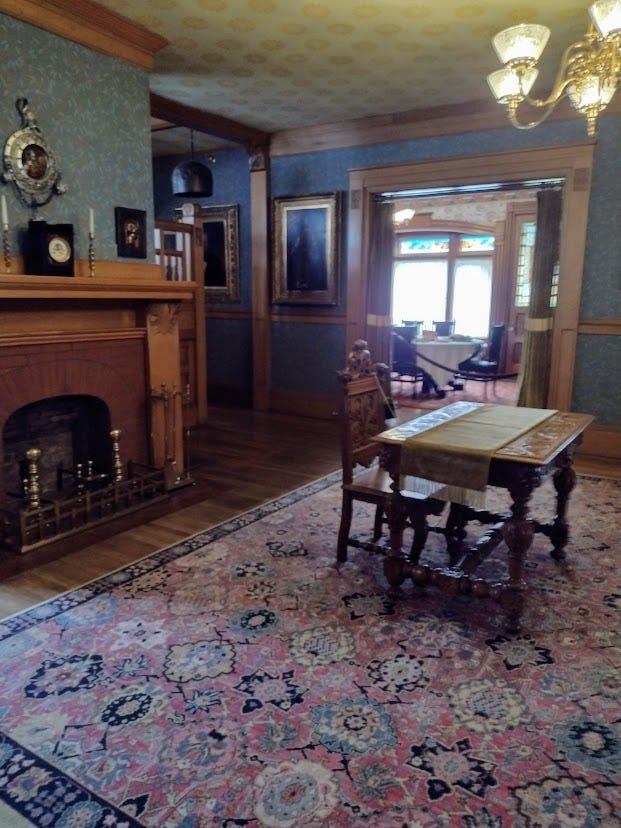
Indeed, there were sliding wooden “pocket” doors in this reception room which were closed so you can’t see into the family room or the dining room that leads off it. The pocket doors are now gone, but they were once there, as I pointed out to a surprised Claire the guide, who examined the doorways and confirmed my hunch, while everyone else wondered how that funny little British woman knew such a thing, or thought me some ghastly showing-off Karen.
This reception area, created for the purposes of the odd little ritual I just described, wasn’t here when the Garfields moved in, or even when James died. It was originally the kitchen. The reception area was devised by Mrs. Garfield after her husband's death. That's because, in her very public widowhood, Mrs. Garfield had further converted the home from workplace to middle-class family sanctuary.
On Garfield (man, not cartoon cat)
James Abram Garfield may have been the poorest man ever to have ended up as President, and he was definitely the last United States President to be born in a log cabin, a type of tiny dwelling that definitely wasn’t a lifestyle choice in 1831.
Not only was James Garfield’s family poor, but they got poorer: His dad, Abram, died when he was a baby, and he and his four siblings were raised in poverty by his single mother, Eliza.
Like many Americans, and especially in new Midwestern states like Ohio, the Garfields were repeat migrants. Eliza’s family started out in Wales, something of which she was very proud, while Abram’s came from Warwickshire, Shakespeare’s county, two centuries before James’ birth. The first American Garfields came over as part of the Great Migration of Puritans in 1630 who started Massachusetts. But, like many poor New Englanders, some Garfields eventually moved on to New York State, where land was cheaper.
Garfield’s dad, Abram, traveled to Ohio all the way from rural New York to propose to the girl of his dreams. He arrived to discover she had already married someone else, and so, not wanting to waste the journey, he married her sister instead.
When James was a baby, Abram and his wife Eliza were caught up in the Second Great Awakening of the early 1830s, a massive evangelical Christian movement that swept America. As an early Americanist, I’m more familiar with the first Great Awakening (about a century earlier) but the second was just as profound. The Garfields got religion, but Abram died not long after. James, as the youngest, became very close to his mum, Eliza.
So, in short, young James Garfield was poor, fatherless, and after his mother remarried and then divorced, a member of a scandalous family. He was ostracized by his peers.
But he had the kind of rags-to-riches success story that Victorian Americans loved, and that were broadcast in the books of Horatio Alger. Indeed, Alger wrote a biography of Garfield called From Canal Boy to President. Alger’s implied message was that if you're not rich, you’re just not trying hard enough, a message that has caused Americans great anxiety from that day to this, and kind of ignores the roles of inherited wealth, connections, corruption, and plain old luck in gaining worldly success.
James Garfield didn’t have boyhood friends. So, instead, he read books, and learned. He left home at 16, and tried working on the new canals of the 1840s. But illness forced him home. His mother encouraged him to try school, which he did, and the education bug bit him.
After two years of schooling, he was determined to go to college. Working as a part-time teacher, carpenter, and janitor, James Garfield paid his own way through Williams College in Massachusetts. And before anyone says “He couldn’t afford to do that now,” he would certainly have qualified for full financial aid today.
When I read Garfield described as a “radical Republican” and an abolitionist, I figured I had a handle on his politics. But I quickly realized that no, I don’t, and I don’t have time to learn enough to write confidently on his career.
I really don't get 19th century politics —good luck getting that kind of honesty from pretendy “historians” of the blowhard fake variety! Sure, Garfield was radical: He supported abolition, and education for former slaves. But he opposed the eight hour day, labor unions, and federal government relief during economic downturns. So I’m not going to write about his politics until I read a book or two.
Back to Garfield’s house and family!
Garfield’s Doting Mum
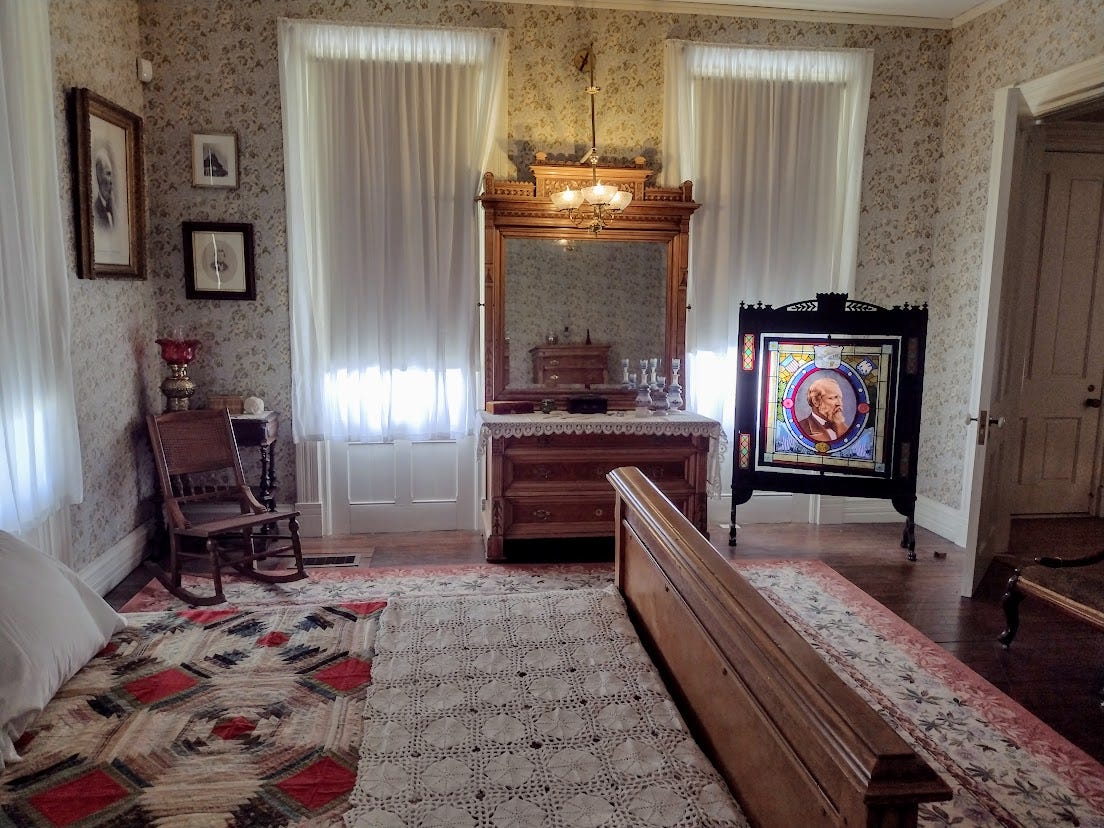
I started to get a feeling of looming tragedy when the tour got to this room. This was where Garfield’s mum Eliza lived when she moved in with the family. Check out the impractical but gorgeous Victorian stained glass firescreen emblazoned with Garfield’s face in the top right corner. A firescreen is supposed to prevent burning embers entering the room from a fireplace. In summer, when the fireplace wasn’t used, the fire screen served as a decorative thingy.
This firescreen, featuring Garfield’s head in stained glass, is just one of several images of Garfield in his mother’s bedroom, as you can see above. Eliza outlived her favorite child, the boy who, unbelievably, had become president, by several years. It was, it seemed to me, a tragic room, a fragile room. I was already thinking of the gloomy Garfield home as a very sad place.
Yet this was also a home filled with people, judging from the number of bedrooms. This one caught my eye because of the delicately patterned carpet.
Let’s take a closer look, shall we?
WHAT HELL IS THIS? Was President Garfield a Nazi before Nazis were a thing?? No worries. The swastika was a symbol of good luck before the Nazis ruined it. Please try to look at this carpet from the perspective of people who had never heard of Hitler, and would be horrified if they had.
Real, Flesh and Blood Americans: A President and His Family
Room by room, the Victorian Garfield family came to life. The dining room, where they gathered, was a typically formal middle-class Victorian room, sure. But the dining room was warmed by a fireplace surrounded by individually painted tiles that every child had a hand in creating.
Suddenly, I was intrigued. Painting personalized tiles was a project that suggested a happy home.
There were at least two pianos, so this wasn’t the quiet house that greets us today: I imagine a kid or two was always bashing away on the ivories. No, wait, they were Victorians . . . Playing the piano properly, with straight backs. Or was I stereotyping?

Garfield’s children remained a muddled lot in my head, but I did enjoy the teenage girl room, with its “Turkish corner”, bright fabric wall hangings over a daybed, kind of like having a batik hanging over a beanbag for a later generation, and its cluttered dressing table (think loads of make-up today).
Garfield’s library was a very masculine space, just what you would imagine a Victorian father would have. A sort of ship feel to the design. Pictures of Civil War Union General William T. Sherman, French dictator Napoleon Bonaparte, and founder of Germany Otto Von Bismarck, an odd collection of powerful men, lined up on the walls.
And, of course, a huge, eclectic book collection, including the delightfully titled Brain Hygiene, a Victorian manual of psychology from the people who brought you measuring heads to check for mental illness (Oh, and Americans, gotta love your often slightly odd applications of the word “hygiene” over the years, just saying. Love you. Mwah.)
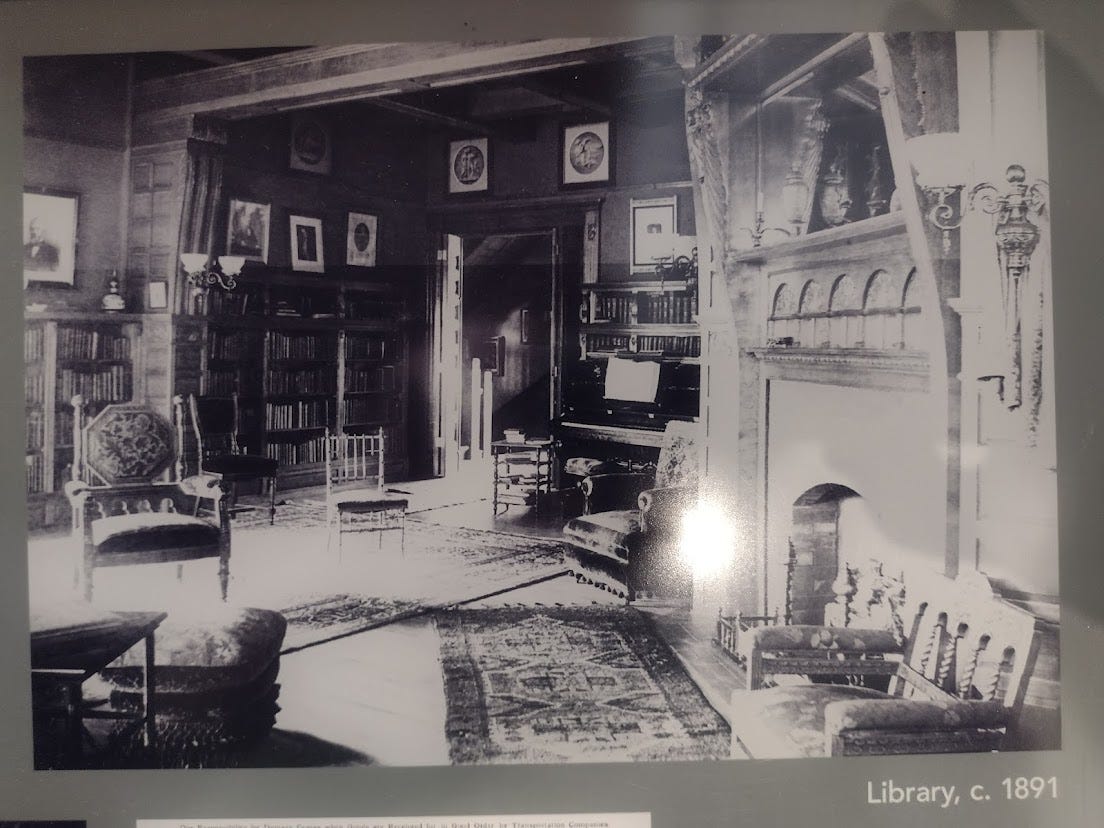
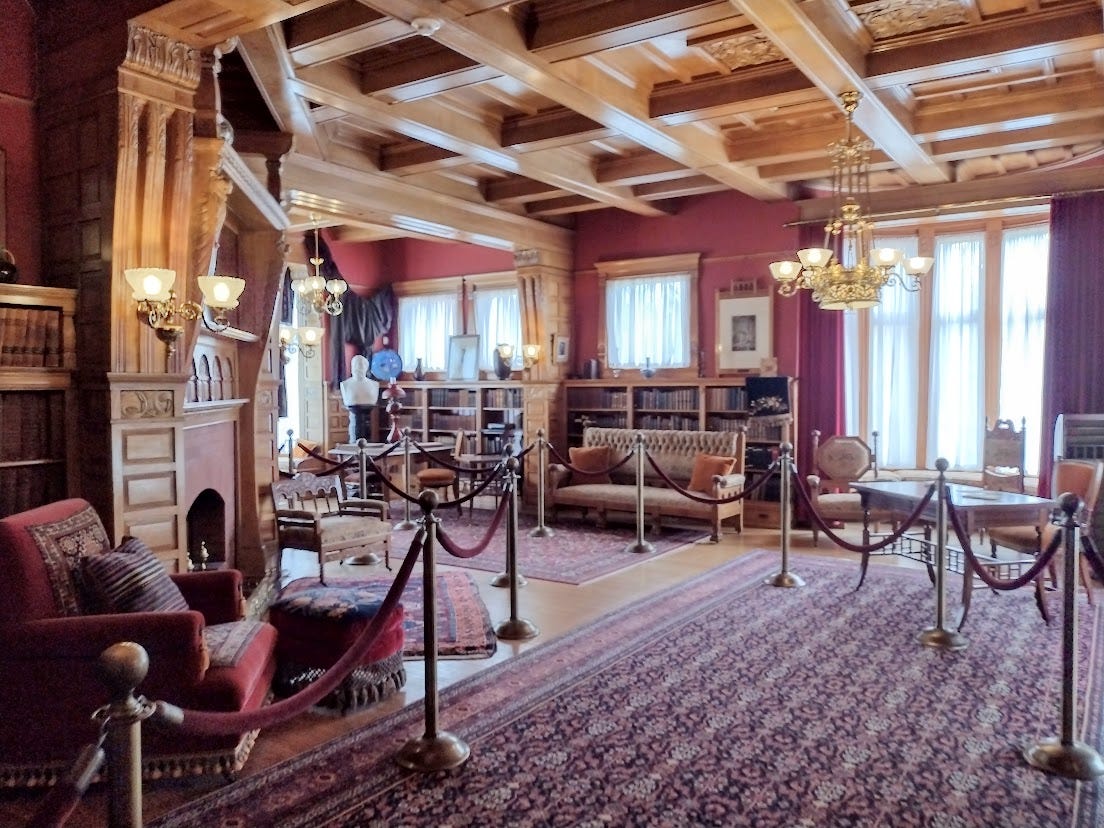
The highlight of the house in my view, though, was this chair in Garfield’s study. His kids had it made for him in light of Dad’s habit of sitting in a desk chair sideways while reading, draping his legs over the side. Can’t you just see him lounging in this? Much less formal and stuffy than his portraits and the library suggest!
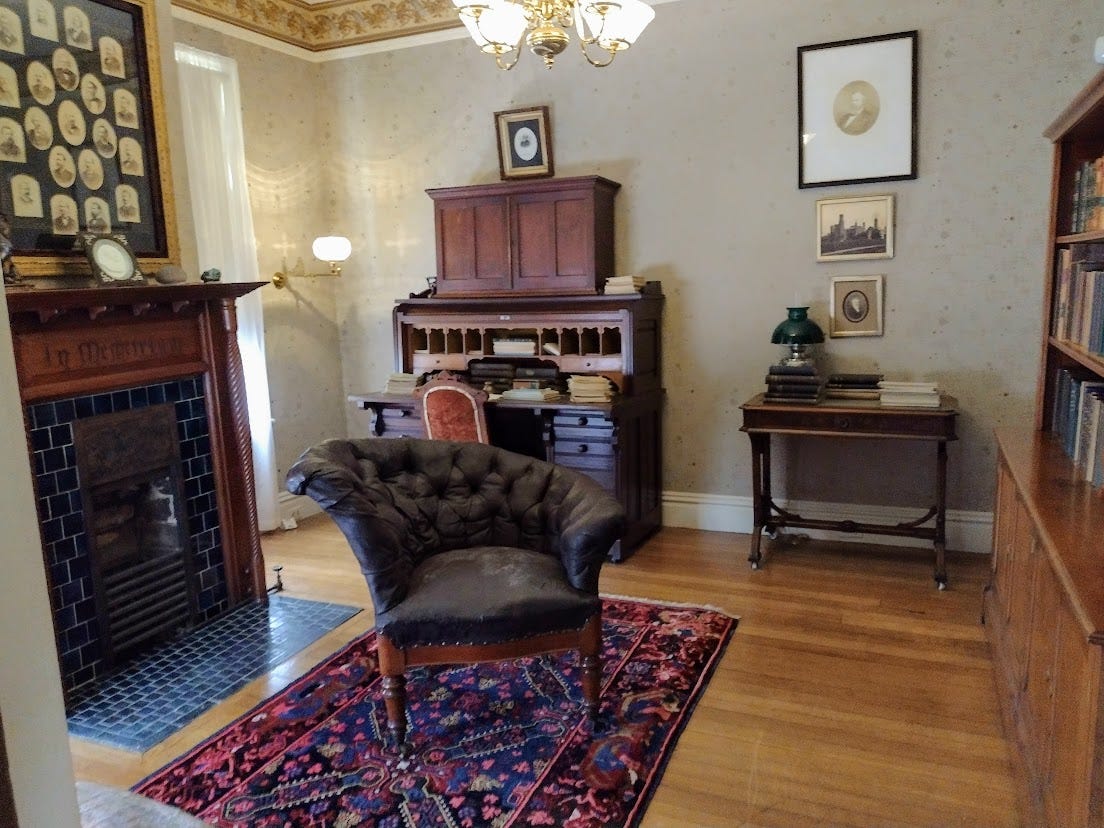
A Real Victorian Woman: Mrs. Garfield Takes Charge
For me, Lucretia Garfield did not come at all into the picture until Garfield’s assassination, and then, boy, did she. A Victorian GoFundMe raised the equivalent of millions for the family, and Lucretia sprang into action with the money. She had all the farm buildings (except the house) moved back on the lot, away from the road, and the house expanded to be more befitting of a martyred president. She completed Lawnfield’s emphasis as a respectable middle-class family home that received frequent visitors, more than a working farm.
And Lawnfield was an increasingly modern home. A widowed Lucretia did not shrink away from technical stuff. She learned that there was a source of natural gas on the property, and had the power source converted to gas from coal. The gas house is still on the grounds, next to the visitor center.
Garfield 's library now became the focus of Lawnfield’s third role as a semi-public shrine to a martyred President. Lucretia expanded the library in the years after her husband’s death, adding a walk-in safe for official documents that even included a desk for researchers who hopefully didn't have claustrophobia. Lucretia basically created the first US Presidential Library, although the official holder of that title is the purpose-built Franklin D. Roosevelt Presidential Library in Hyde Park, New York.
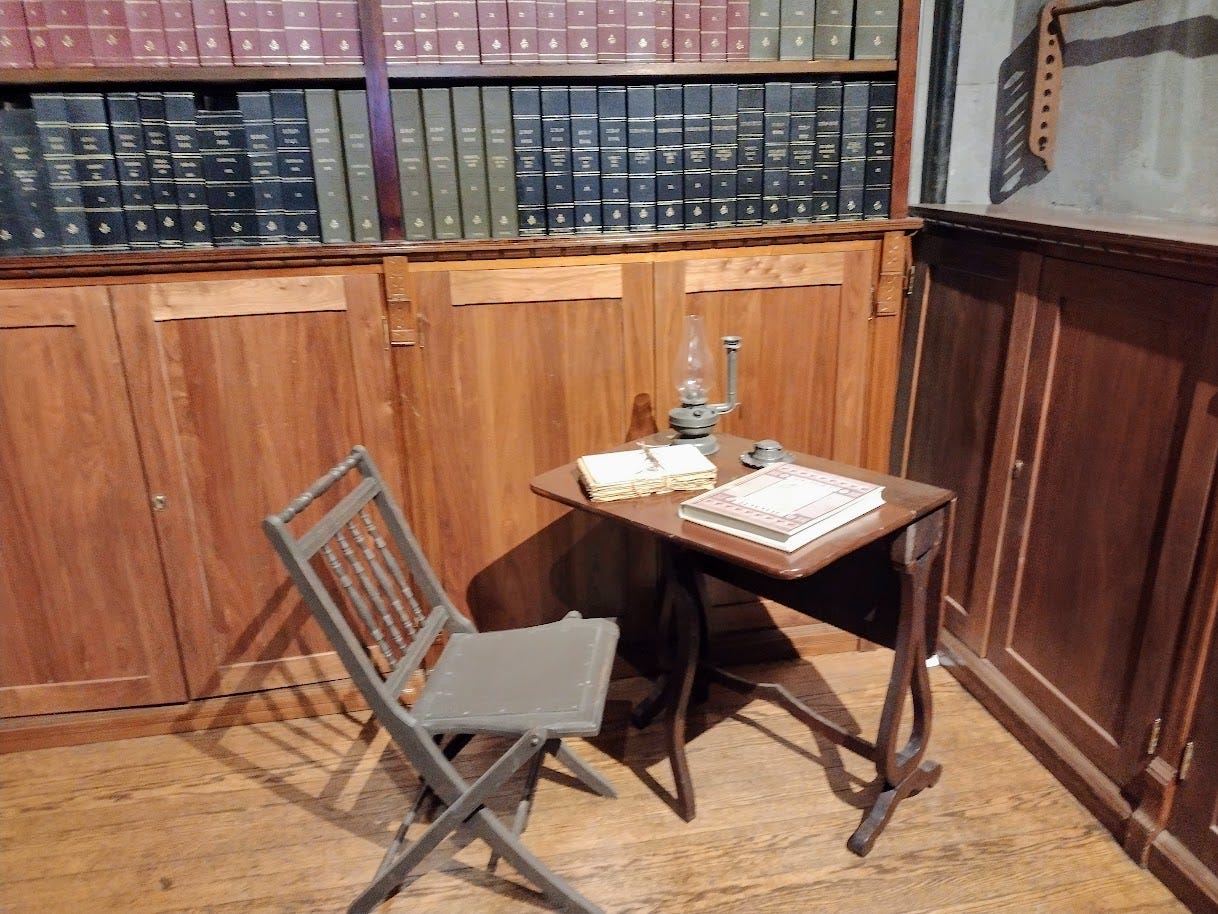
There's even a touch of Lucretia in the remodeled library: A photo of Queen Victoria, who had written Lucretia a letter after James's death.
Queen Victoria, who became a professional widow after Prince Albert’s early death at age 41, twenty years before Garfield’s assassination, wrote Mrs. Garfield a very sweet letter of consolation, which you can also see on site. I was pleasantly surprised by her words. I thought Victoria would, as usual, turn the letter’s subject immediately to Albert (Never mind your husband, what about mine?) but she only did that a little bit in her note to Lucretia Garfield.
When Death and Life Came to Lawnfield
A deranged assassin named Charles Guiteau shot James Garfield at a train station in Washington DC in September 1881, just three months after he was inaugurated.
Garfield took two months to die, and might even have survived if his doctors had paid more attention to British surgeon Joseph Lister’s work, and not messed around in Garfield’s wound with unwashed hands and instruments.
Garfield was popular, and especially so after his death, only 100 days into his presidency, because it came as such a shock to the nation. In the museum in the visitor center, you will find all the creepy Victorian cult of death stuff on display: The preserved mattress used as an improvised stretcher to get him from the train station to a bed. The black-bordered stationery. The death mask. The souvenirs. The works.
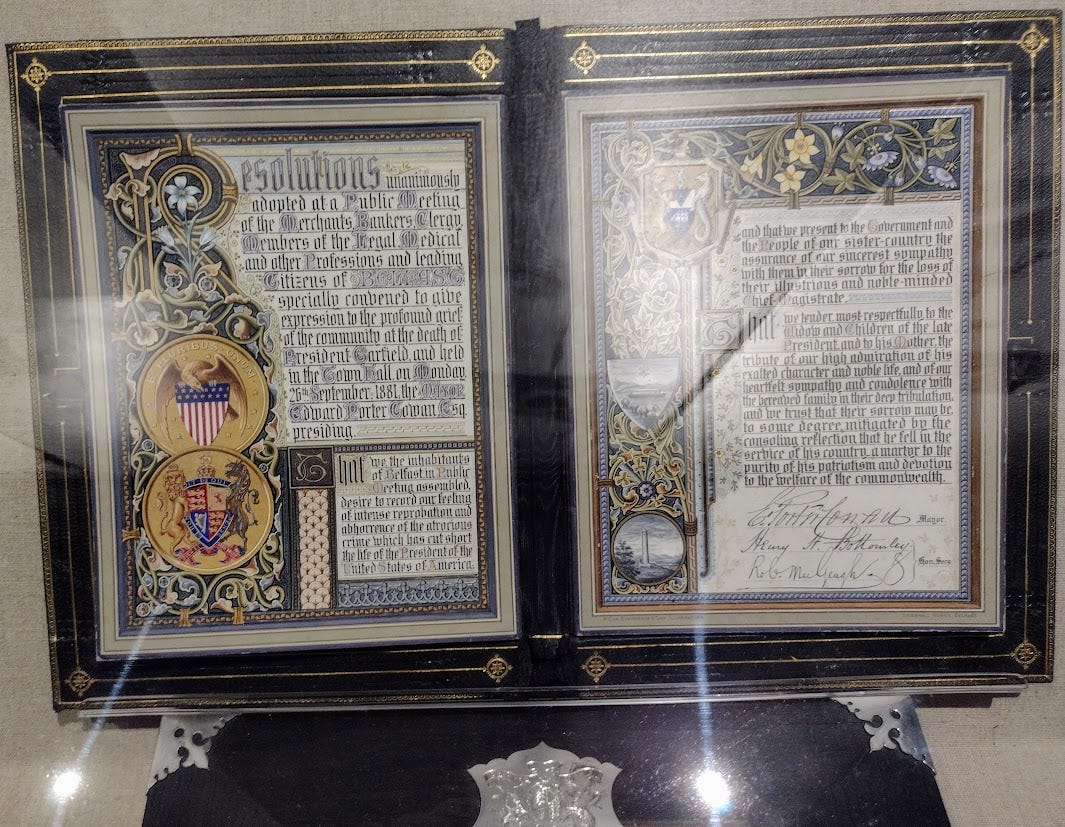
But our tour guide, Claire, insisted that the Garfield children later remembered Lawnfield as a happy, lively place. Wikipedia uses the word “cheerful” to describe the family who came to the White House in 1881. James Garfield, the fatherless boy from poverty (but whose family roots in New England suggested he had inherited educational wealth), and Lucretia Garfield, the intelligent and educated woman of her time whom Garfield met in college in Massachusetts, had done well by their five surviving children.
Alone, Lucretia took charge, caring for kids, mother-in-law, home, and new role as Presidential widow. These people aren’t remote and fascinating relics. They’re real. Lucretia Garfield long outlived her husband, and spent at least part of the year at this house until her own death in 1918.
Before leaving, I had a chat with Mary the National Parks Service ranger at the reception desk. Yes, Mary was one of those unlikely-looking museum staff in a quasi-military uniform with broad hat, Brits, don’t worry, I don’t get it either. But Mary was very pleasant.
She asked me where Hoosen and I were headed next, and I told her. She said, “Oh, but you’ll know about Guiteau, of course?”
No. I didn’t know about Guiteau and his connection to my next destination. But I was about to find out.
Nothing is new
This post first appeared in earlier form (not much different) at Non-Boring History in 2022. Our next stop, long planned (unlike our stop in Mentor, Ohio), was in New York State, about 350 miles away. By astonishing coincidence, it really did have a direct connection with James Garfield, and also a very different interpretation of domestic bliss from the Garfield home in Mentor.
Did you know? Become a paid subscriber and you get access to all my work. That includes EVERY weekly Tuesday post and my Sometimes Saturday posts for supporting subscribers only. It's a deal, I tell you! Going paid also gives you access to more than five hundred other still-fresh posts, including these, about our fascinating visit to a unique place in New York State that followed our stop in Mentor:
Part 2 includes my chat with Dr. Tom Guiler, the resident historian at this truly astonishing site in New York:









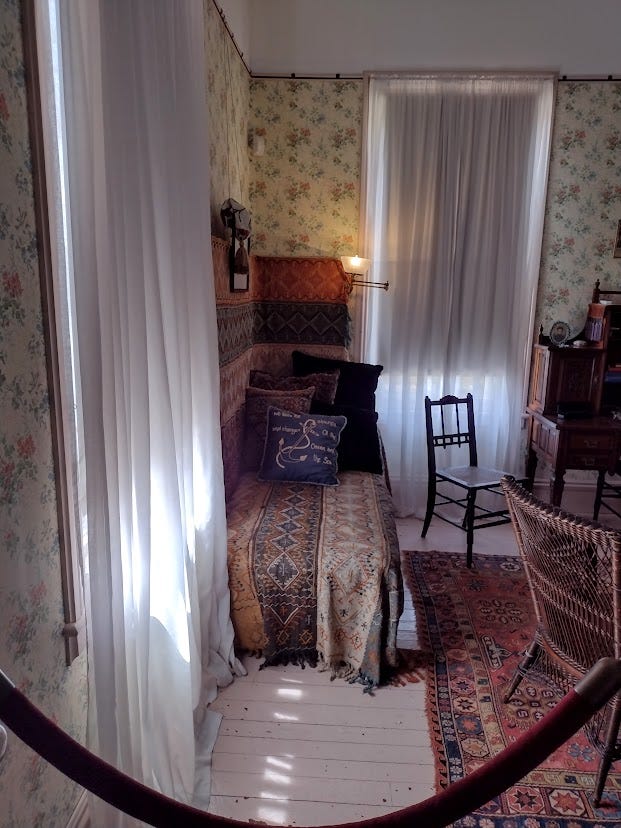




Smokey doesn't have a middle name; he's just Smokey Bear. You being a Brit, you're forgiven.
So interesting!
When my mother came to Oxford from Barnard in c. 1957, her new college was disconcerted to see on her transcript a B for hygiene. Turns out it meant posture …